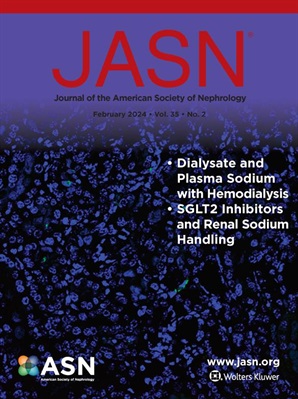Bmpr2 Drives Aberrant Activation and Injury of Glomerular Endothelial Cells in Lupus Nephritis.
IF 9.4
1区 医学
Q1 UROLOGY & NEPHROLOGY
引用次数: 0
Abstract
BACKGROUND Lupus nephritis, a severe complication of systemic lupus erythematosus, is closely associated with the abnormal activation of glomerular endothelial cells. Despite its significance, the core mechanisms underlying glomerular endothelial cell activation remain elusive. METHODS We performed single-nucleus RNA sequencing (snRNA-seq) on kidney tissues from lupus nephritis patients and mouse models to investigate transcriptional alterations in glomerular endothelial cells, and validated our findings in two lupus nephritis models: pristane-induced lupus nephritis and MRL/lpr mice. Genetically modified mice and cultured cells were employed to further validate the key discoveries. Additionally, a panel of cytokine stimulations was used to elucidate the underlying causes of glomerular endothelial cell injury in lupus nephritis. RESULTS Bmpr2 was identified as a critical regulator, showing significant upregulation in glomerular endothelial cells from both lupus nephritis patients and mouse models. Elevated Bmpr2 expression correlated with enhanced glomerular endothelial cell proliferation, migration, and increased expression of adhesion molecules (Vcam1, Icam1). BMPR2 activated SMAD-dependent pathways, leading to the upregulation of downstream targets ID1 and ID3, thereby promoting glomerular endothelial cell hyperactivation. Bmpr2 overexpression amplified glomerular endothelial cell proliferation and migration, whereas inhibition of ID signaling by DMH2 or endothelial-specific Bmpr2 knockout attenuated these effects. Moreover, targeting BMPR2 signaling reduced the infiltration of CD86+ macrophages into lupus nephritis kidneys. Co-culture experiments confirmed that Bmpr2-activated glomerular endothelial cells promoted macrophage differentiation into an inflammatory phenotype. Complement component C5a was identified as a critical upstream inducer of Bmpr2 in glomerular endothelial cells, and inhibition of C5a signaling with the C5aR1 antagonist PMX-53 effectively suppressed Bmpr2 upregulation. CONCLUSIONS These findings highlight BMPR2 as a key regulator of glomerular endothelial cell injury and macrophage-mediated inflammation in lupus nephritis. Targeting BMPR2 or its upstream activators, such as C5a, effectively treated and improved lupus nephritis.Bmpr2驱动狼疮性肾炎肾小球内皮细胞异常活化和损伤。
狼疮性肾炎是系统性红斑狼疮的严重并发症,与肾小球内皮细胞的异常活化密切相关。尽管具有重要意义,但肾小球内皮细胞活化的核心机制仍然难以捉摸。方法对狼疮性肾炎患者和小鼠肾脏组织进行单核RNA测序(snRNA-seq),研究肾小球内皮细胞的转录变化,并在普利坦诱导的狼疮性肾炎和MRL/lpr小鼠两种狼疮性肾炎模型中验证了我们的发现。转基因小鼠和培养细胞被用来进一步验证这些关键发现。此外,一组细胞因子刺激被用来阐明狼疮性肾炎肾小球内皮细胞损伤的潜在原因。结果bmpr2在狼疮性肾炎患者和小鼠模型的肾小球内皮细胞中被鉴定为一个关键的调节因子,显示出显著的上调。Bmpr2表达升高与肾小球内皮细胞增殖、迁移和粘附分子表达增加相关(Vcam1, Icam1)。BMPR2激活smad依赖通路,导致下游靶点ID1和ID3上调,从而促进肾小球内皮细胞过度活化。Bmpr2过表达会增强肾小球内皮细胞的增殖和迁移,而DMH2或内皮特异性Bmpr2敲除对ID信号的抑制会减弱这些作用。此外,靶向BMPR2信号通路可减少CD86+巨噬细胞在狼疮肾炎肾脏的浸润。共培养实验证实bmpr2激活的肾小球内皮细胞促进巨噬细胞向炎症表型分化。补体成分C5a被认为是肾小球内皮细胞中Bmpr2上游的关键诱导剂,用C5aR1拮抗剂PMX-53抑制C5a信号传导可有效抑制Bmpr2上调。结论BMPR2是狼疮性肾炎患者肾小球内皮细胞损伤和巨噬细胞介导炎症的关键调节因子。靶向BMPR2或其上游激活剂,如C5a,可有效治疗和改善狼疮性肾炎。
本文章由计算机程序翻译,如有差异,请以英文原文为准。
求助全文
约1分钟内获得全文
求助全文
来源期刊
CiteScore
22.40
自引率
2.90%
发文量
492
审稿时长
3-8 weeks
期刊介绍:
The Journal of the American Society of Nephrology (JASN) stands as the preeminent kidney journal globally, offering an exceptional synthesis of cutting-edge basic research, clinical epidemiology, meta-analysis, and relevant editorial content. Representing a comprehensive resource, JASN encompasses clinical research, editorials distilling key findings, perspectives, and timely reviews.
Editorials are skillfully crafted to elucidate the essential insights of the parent article, while JASN actively encourages the submission of Letters to the Editor discussing recently published articles. The reviews featured in JASN are consistently erudite and comprehensive, providing thorough coverage of respective fields. Since its inception in July 1990, JASN has been a monthly publication.
JASN publishes original research reports and editorial content across a spectrum of basic and clinical science relevant to the broad discipline of nephrology. Topics covered include renal cell biology, developmental biology of the kidney, genetics of kidney disease, cell and transport physiology, hemodynamics and vascular regulation, mechanisms of blood pressure regulation, renal immunology, kidney pathology, pathophysiology of kidney diseases, nephrolithiasis, clinical nephrology (including dialysis and transplantation), and hypertension. Furthermore, articles addressing healthcare policy and care delivery issues relevant to nephrology are warmly welcomed.

 求助内容:
求助内容: 应助结果提醒方式:
应助结果提醒方式:


